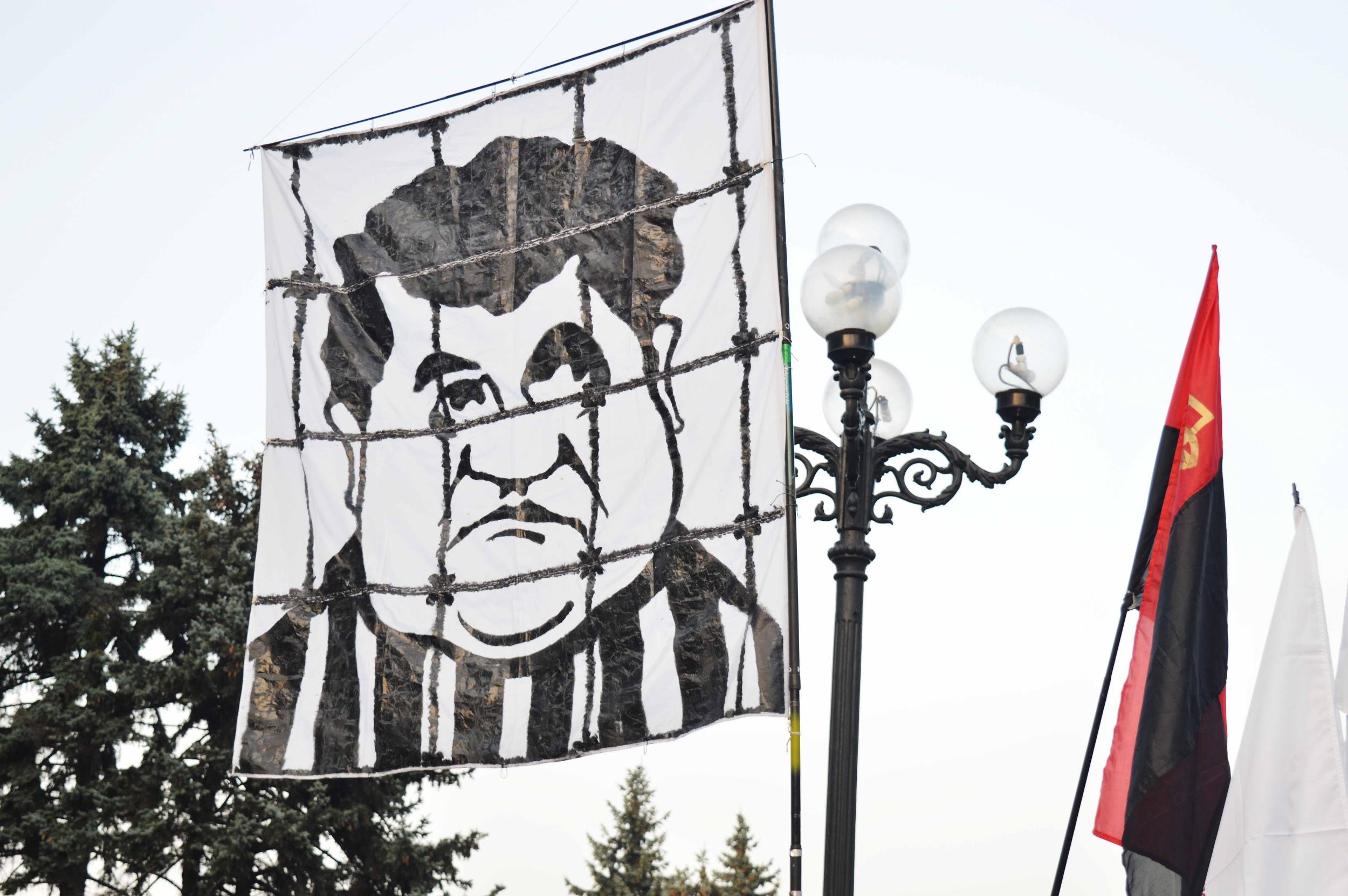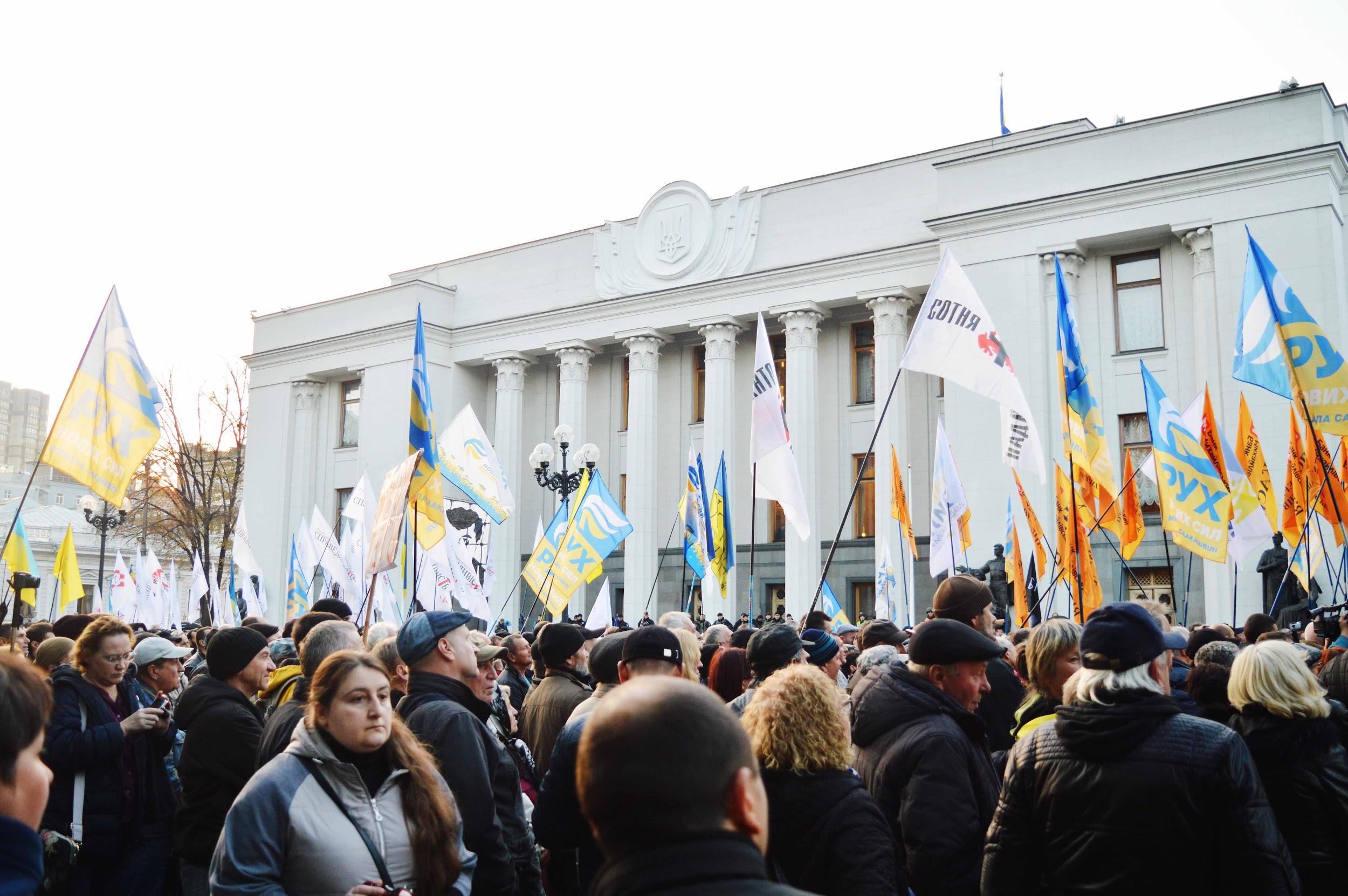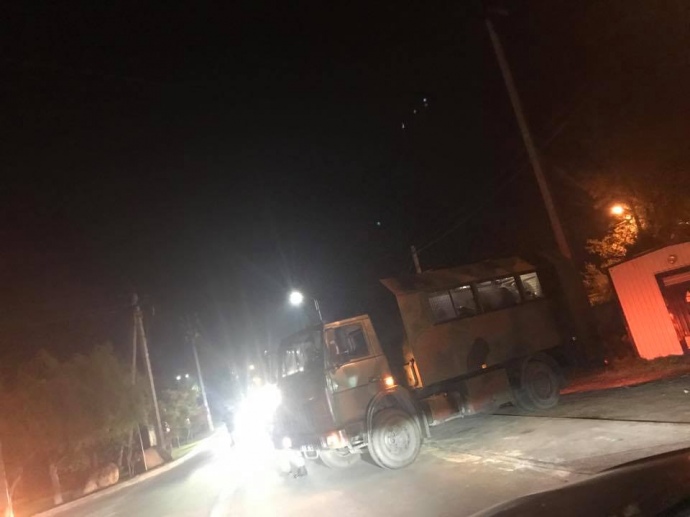On October 17, at least 4,500 people gathered in central of Kyiv to call on the Verkhovna Rada (Parliament) to pass legislation on what activists call the "great political reform."
The protest was planned a few weeks ahead. Among the organizers, there are civil society activists from Civic Movement Chesno, Reanimation Package of Reforms, Anti-Corruption Action Center, as well as a number of MPs – Svitlana Zalischuk, Mustafa Nayem, Serhiy Leshchenko, Yehor Soboliev and others.
One of the central speakers was former Georgian president and Odesa Oblast ex-governor Mikheil Saakashvili.
The government prepared carefully as well. From Monday night, streets located in the government quarter of Kyiv were closed. 3,500 law enforcement officers provided security for the event. Also, metal detectors had been set up near the building of Parliament.

The protesters complained that such measures remind them of the times of exiled president Viktor Yanukovych, when all the governmental forces served to protect those in power from the ordinary people. Nowadays, Ukraine’s government justified such strict security by wanting to prevent the events of August 2015, when four National Guardsmen were killed by a grenade during protests at Parliament.
The demands

Let's take a closer look at why these reasons are in focus of the protesters.
Election Reform.
Ukraine has a mixed voting system, according to which Ukrainians choose their Parliament by electing one-half of the 450 MPs based on the lists of the political parties, and the other half in the majority constituencies.
Denys Kovryzhenko, the Senior Legal Advisor of the International Foundation for Electoral Systems of Ukraine is confident that this scheme in Ukraine includes all the drawbacks of the proportional and majority voting systems:
“The main drawback of the majority component is a big waste of votes. The winner can be a person who gained a minority of votes. Sometimes a person can gain 13% and it will be more than any of competitors get. So the person becomes a deputy even if 87% are against it,” explains Kovryzhenko.
Thus, parties which win according to this component can be supported by the minority of the population, but form a majority and the government.
The second drawback, according to Kovryzhenko, is that this component creates good conditions for using administrative resources – allocating state money and directing it to certain counties where a pro-government candidate is campaigning, which stimulates voters to vote for this candidate.
But the proportional system with closed party lists doesn’t promote the renewal of the political elites either, says Kovryzhenko:
“The place of a candidate in the list is defined by negotiations between the candidate and the party leader. And it is no secret the places in lists are sold at the stage of nomination of candidates. So if we change the existing mixed system to being fully proportional, it would more or less represent the moods within society, but there will be no renewal of the elites because parties would nominate oligarchs or people who are dependent on authorities, and the existing 5% threshold would prevent new political forces from entering the parliament.”
In any case, to prepare a country for the implementation of new legislation, the election reform has to be made some time prior to elections – one year, as the Venice Commission recommends.
The protesters demand to change the current voting system to a proportional one with an open regional system. These changes, according to them, will complicate the widespread occurrence of bribing voters, make purchasing places in the list senseless – as nobody can guarantee voices of the electorate to a particular person, and decrease the electoral threshold to 3% (now it is 5%), which will give small parties a chance to enter parliament.
Read also: Electing bad leaders in Ukraine: how to break the vicious cycle #UAreforms
The Creation of Anti-Corruption Court
is foreseen by the judicial reform launched by the President Poroshenko in 2016. When the protest was planned, the position of the president and his inner circles on the question was not clear enough - for a long time, the establishment advocated for the creation of anti-corruption chambers in every court. Due to the low number of courts in the country, civil society saw this to be an imitation of reform.
However, during the last weeks, Poroshenko’s rhetorics on the issue changed dramatically – he supported the idea of a full-fledged Anti-Corruption Court. It happened just before the Venice Commission released its recommendations to Ukraine.
Read more: Civil society sees EU as a safeguard for creating Anti-Corruption Court in Ukraine
There were two bills on the Anti-Corruption Court: one developed by activists, considered as opposing the government, and one was registered by MPs from Petro Poroshenko’s Bloc. It foresaw the creation of anti-corruption chambers.
Neither of the bills was recommended by the Commission. Instead, the recommendations envisage creating a third law based on the one proposed by the activists. At the same time, the Venice Commission concluded that the bill supported by the President contradicts Ukrainian legislation and that the creation of chambers might have a negative effect on the fight against corruption. However, the new law should be submitted by the President.
There are two main instruments with which Poroshenko and his inner circle can prevent this reform from happening not just on paper but in reality:
- First, protracting. Doing this in Ukraine is simple – by assembling different working groups in the Parliament in order to delay creating and passing a corresponding law. This happens so often that even politicians sometimes joke that creating a working group is the best way to fail the case. As Lemenov told, the president might delay with the creation of the court until the next elections, which will happen in 2019. So even if the law is passed now, there will be delays with its implementation and Anti-Corruption Court will not be functional until the end of 2018.
- Second, not letting the independent international experts to take part in the process of selection of judges, because the “needed” candidates will easily get into the newly created court without them:
“You’ll see, their main argument against it will be that the participation of international experts is an element of external intervention in inner affairs of Ukraine which leads to the loss of a part of sovereignty of the country,” Oleksandr Lemenov, an expert of Reanimation Package of Reforms, a network of NGOs advocating Ukrainian reforms, explained to Euromaidan Press.

The cancellation of parliamentary immunity,
according to the activists, will allow to prosecute MPs on a general basis, but keep their indemnity, so it will not be possible to prosecute parliamentarians on the base of their political stance and statements.
The activists claim that the question of cancellation of parliamentary immunity is on Ukraine’s agenda for the last 20 years, and that every political force promises to implement this requirement as soon as it gets to parliament. The activists are calling to move the question forward.
The results of the first day

Despite a few minor conflicts, the first part of the day was peaceful. Traditionally, Mikheil Saakashvili recommended Poroshenko to think about resignation and said that as long there is Poroshenko, there will be no progress in Ukraine.

“As long as there is Poroshenko, there will be no fight against corruption! As long as there is Poroshenko, there will be poverty, humiliation, emigration, especially of youth. There will be the fall of Ukraine's prestige, money, including that allocated for defense, will be stolen,” said Saakashvili.
When the protest started, the president promised to fulfill the requirements of the protesters. In particular, he registered the bill (#7203) which envisages amendments to the Constitution on cancellation of parliamentary immunity.
But there is one controversial detail. If the Parliament votes for the bill suggested by the president, the law will come into force only on 1 January 2020. The activists do not agree to such a delay.
The speaker of the parliament Andriy Parubiy in his turn ordered to put the demands of the protesters on the agenda. However, these questions have to be considered after the medical reform.
The morning parliamentary session was closed less than in an hour of work.
The first clashes started about 4 P.M. closer to the beginning of the evening parliamentary session. The protesters were trying to put up tents in the square near the building of Parliament but were prevented from doing so by the law enforcement officers. In the end, the protesters managed to do it and started to establish a camp. During the incident, one activist and one soldier of the National Guard were injured.
The second major incident happened when an MP from Petro Poroshenko’s Bloc Oleр Barna was attacked when he tried to leave the building of the parliament.
After 10 P.M., the protesters and police clashed again over the police’s obligation to check everyone who enters and exits the protester’s camp.

Meanwhile, during the evening session, Ukrainian MPs passed about 250 amendments on the healthcare reform. The demands of the street were not fulfilled. An MP from Petro Poroshenko’s Bloc assumed that the plan of leaders of the Parliament coalition, Petro Poroshenko’s Bloc and Narodnyi Front, is to pit the ssupporters of the healthcare reform and supporters of political reform against each other.
The Parliament will continue its work on October 18, 10:00 a.m. at the next parliamentary session.

Also, in the evening, MP Viktoria Voitsytska informed that law enforcement officers and military hardware is taken to the private residence of Poroshenko in Kozyn. The MP asked the law enforcement representatvies what is the reason for such security mesures. They told her that a training is taking place.


